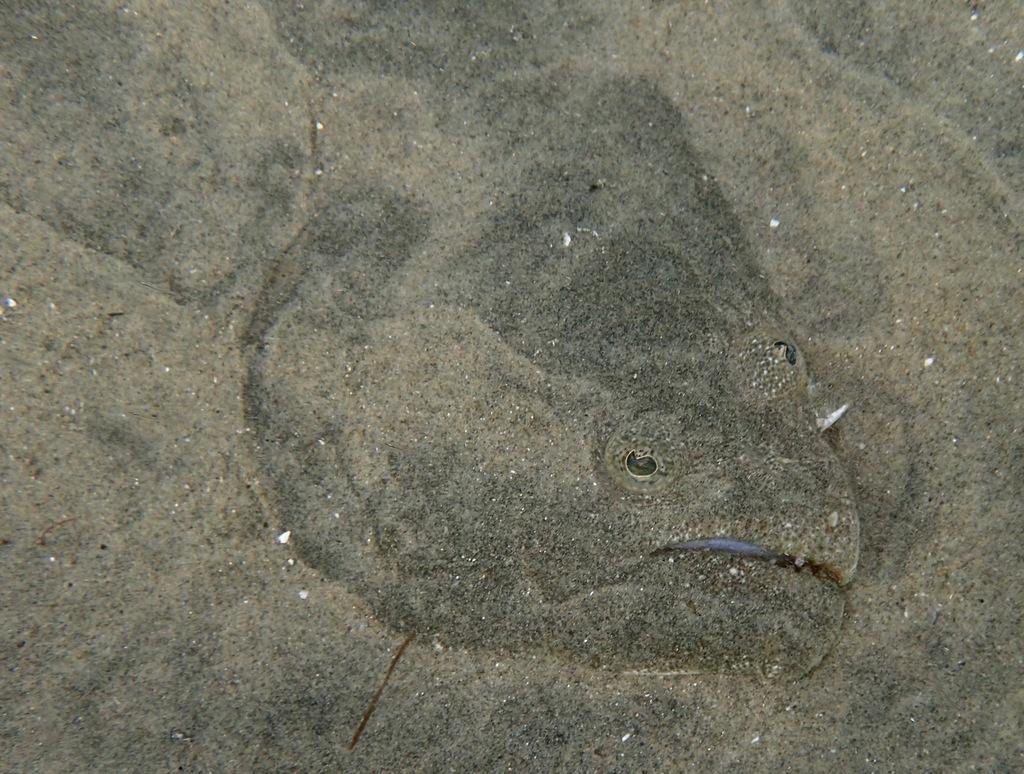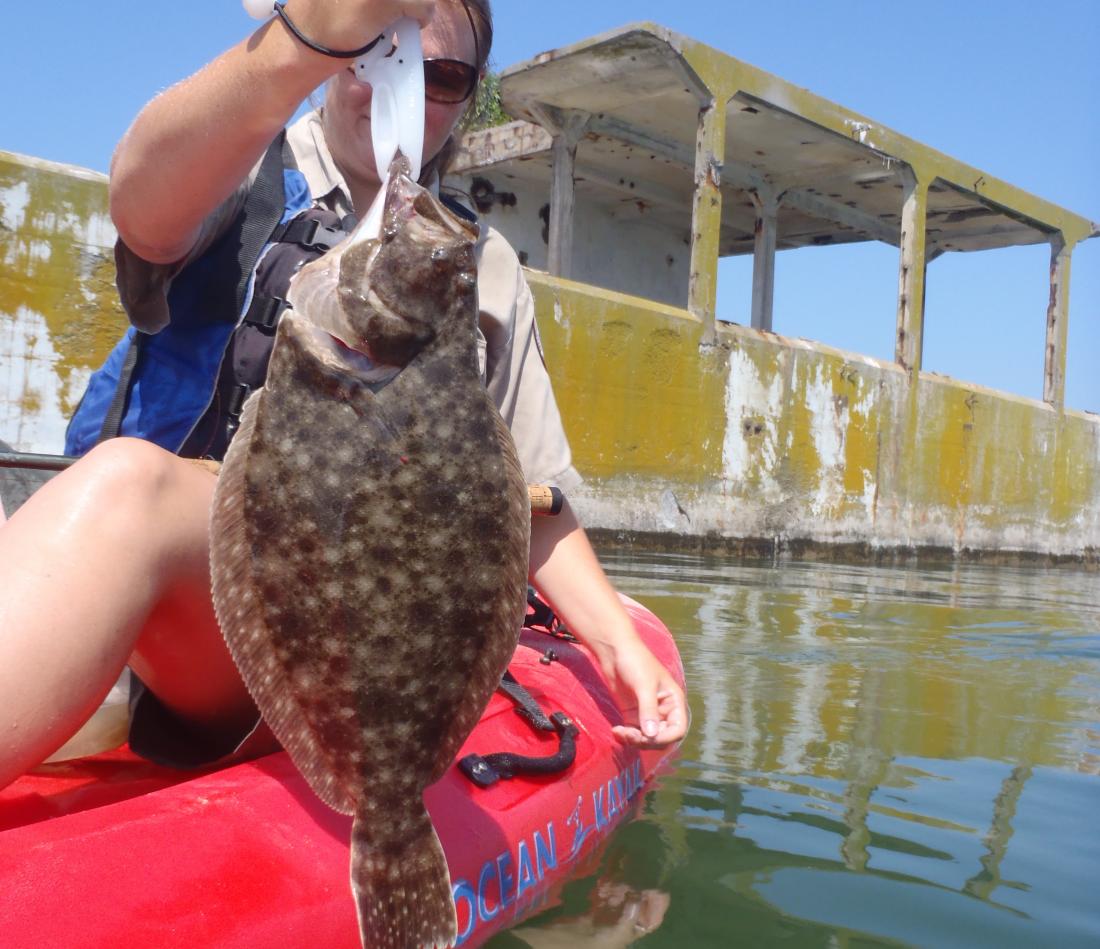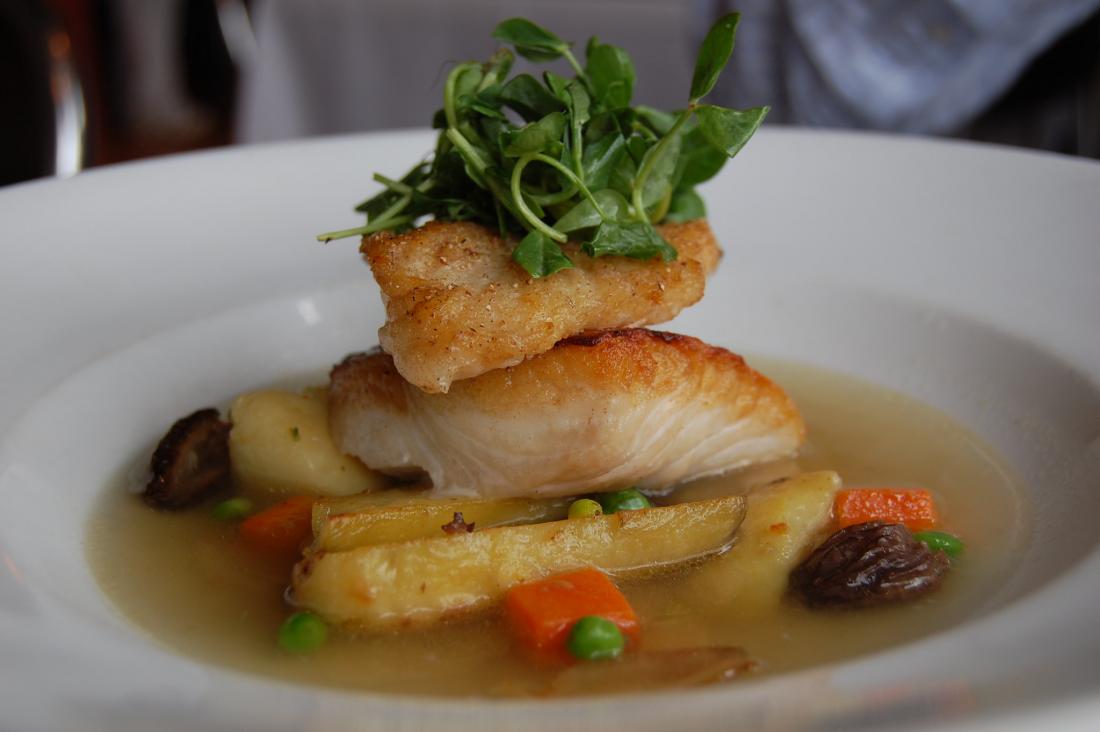California Halibut
Paralichthys californicus
The Science
THE SCIENCE
It is born with an eye on each side of the body, but as it matures one eye migrates to the other side. California Halibut can be left-eyed or right-eyed!

Taxonomic description
- Has a small head with large mouth full of teeth. [5]
- Both eyes are on one side of the body so that the fish can lay flat on the seafloor with eyes facing up. [5]
- Eyed side of the body is usually grayish or greenish-brown, and mottled with lighter and darker spots to camouflage with the cobbles, sand or mud of the substrate. The blind, “underside” side is white to cream. [3,4]
- Can reach lengths of 150 cm (60 “). [2]
Distribution
- Found from Magdalena Bay, Baja California, Mexico to Washington state, with a separate population in the upper Gulf of California. [3]
- Most occur south of San Francisco. [4]
Life history
- Major spawning areas are unknown, but the spawning season extends from February to July with most spawning in May. [4]
- Adults come up from relatively deep offshore water to spawn inshore at depths of 5-18 m (16-60 feet). [4]
- Eggs are deposited on the substrate surface and fertilization is external. [4]
- Larvae and post-larvae are pelagic for serveral months before settling on the bottom, likely in bays and estuaries. [4]
- The juvenile halibut emigrates to deeper water after 1 year and/or at 20 cm in length. [1,4]
- Maturity is reached after 2- 3 years for males and 3 - 5 years for females; both may live 30 years. [3,4]
Habitat
- Demersal (lives on the sea floor) during its juvenile and adult stages, mostly on sandy sediments.
- Uses bays and estuaries as nurseries, possibly to decrease the risk of mortality of newly hatched fish. [2,4]
- Planktivorous as a larvae and juvenile, piscivorous as an adult. [4]
- Lives from the surf zone to 100 m (330 ft) but is most abundant around 30 m (100 ft). [1,4]
- Lies flat and very still, buried or partially buried in sediment on the sea floor where it ambushes its prey, specifically free swimming fish (e.g., Pacific sardine and northern anchovy). [2]
The Fishery
THE FISHERY
Most California halibut landed is consumed domestically, with very little going to export.

Seasonal availability
- Commercial fishing is open year-round except trawl fishery, which is open June 16-March 14. [7]
Regulatory and managing authority
- As established by the Marine Life Management Act, the California Fish and Game Commission (CFGC) regulates the fishery in state waters, and the California Department of Fish and Wildlife (CDFW) manages this fishery through the Northern and Central California Finfish Research and Management Project. [7,15]
Gear type
- 50% of statewide landings from bottom trawl are caught only within specified trawling grounds, 25% are caught by hook-and-line, and the other 25% are caught with trammel or bottom set nets. [6]
Status of the fishery
- When caught with hook-and-line or bottom trawl, California halibut is rated as a “Good Alternative” by Monterey Bay Aquarium’s Seafood Watch program. [8]
- Stock assessments indicate a trend in depletion from 1971-2011, but further data is required. [9]
Potential ecosystem impacts
- Degradation of estuaries & bays that halibut depend on for nursery grounds paired with its limited range makes it vulnerable to overfishing. [8]
- One quarter of the total catch is caught with gillnets, which can entangle marine mammals & seabirds, so restrictions have been placed on where gillnets can be set. [7]
- Hook-and-line fishing is considered sustainable since gear is rarely in contact with the seafloor.
- Stocks are maintained through a minimum size requirement of 55 cm (22”) length, which allows a chance for the fish to spawn before being eligible for take. [7]
The Seafood
THE SEAFOOD
The skin only moderately shrinks when cooked, allowing for fillets to be fried or poached without distorting the meat.


Edible portions
- Usually available as fillets.
Description of meat
- Lean fish with a mild, sweet flavor.
- Meat includes large, white flakes with a firm and tender texture because of its rich oil content.
Culinary uses
- Cook this fish while fresh! Because of the leanness of the fish, freezing can cause the loss of moisture, and it is easy to overcook & dry out. Cook to an internal temperature of 52-54°C (125–130°F) to ensure the fish stays moist and tender. [12]
- Common preparations include baked, broiled, batter-fried, pouched, sautéed, steamed, sushi.
- Takes on the flavor of any seasoning or sauces you cook it in, making it a great fish to sauté rather than grill.
- Cooking tip: Once sautéed and before it fully cooks, place the pan in the oven to allow the fish to capture the richness of all the flavors. [13]
Nutritional information
- Information available for 100g of haliut cooked with dry heat (5.6 oz). [10]
Toxicity report
- Safe consumption recommendations are 3 servings per month for adults, 2 for kids 6-12 yrs, & 1 for kids 0-5 yrs old as Halibut has potentially elevated levels of mercury. [11,12]
Seasonal availability
- Available fresh year-round.
References
[1] Seafood Watch. n.d. California Halibut. Monterey Bay Aquarium. Web. https://www.montereybayaquarium.org/animals/animals-a-to-z/california-h…. Accessed 26 August 2020.
[2] Tanaka, T. 2011. California Halibut, Paralichthys californicus. 2011 Status of the Fisheries. California Dept. Fish & Wildlife. Web. https://nrm.dfg.ca.gov/FileHandler.ashx?DocumentID=65559&inline. Accessed 27 August 2020.
[3] Miller, D.L., R.N. Lea. 1972. Guide to the coastal marine fishes of California. Calif. Dept. Fish & Game, Fish Bull. 157. 299p Web. https://escholarship.org/uc/item/6s04v367. Accessed 27 August 2020.
[4] Kucas, S., T. Hassler. 1986. Species Profiles: Life Histories and Environmental Requirements of Coastal Fishes and Invertebrates (Pacific Southwest)-- California halibut. U.S. Fish and Wildlife Service, Biological Report 82 (11.44). U.S. Army Corps of Engineers, TR EL-82-4. 8pp. Web. https://apps.dtic.mil/dtic/tr/fulltext/u2/a172677.pdf. Accessed 27 August 2020.
[5] California Halibut. n.d. Monterey Bay Aquarium. Web. https://www.montereybayaquarium.org/animals/animals-a-to-z/california-h…. Accessed 27 August 2020.
[6] Ish, T., F. Stroman. 2011. Sustainable Fishery Advocates Seafood Report: California Halibut. http://fisheries.tamu.edu/files/2013/09/California-Halibut.pdf. Accesed 27 August 2020.
[7] California Department of Fish and Wildlife. 2020. 2020 California Commercial Fishing in California. Web. https://nrm.dfg.ca.gov/FileHandler.ashx?DocumentID=175639&inline. Accessed 27 August 2020.
[8] California flounder. 2020. Monterey Bay Aquarium Seafood Watch. Web. https://www.seafoodwatch.org/recommendation/flounder/green-flounder-cal…. Accessed 27 August 2020.
[9] California Department of Fish and Wildlife. 2011. Stock Assessment Summary for California Halibut. California Department of Fish and Wildlife. Web. https://nrm.dfg.ca.gov/FileHandler.ashx?DocumentID=36262&inline. Accessed 27 August 2020.
[10] SELF Nutrition Data. 2013. "Fish, halibut, Atlantic and Pacific, cooked, dry heat." USDA SR-21, n.d. Web. https://nutritiondata.self.com/facts/finfish-and-shellfish-products/406…. Accessed 10 August 2013.
[11] Environmental Defense Fund Seafood Selector. 2013. “Halbiut”. Web. http://seafood.edf.org/halibut. Accessed 27 August 2020.
[12] Buchanan, D. 2010. Halibut Culinary Information. Chef's Resources: Culinary Knowledge for Professional Chefs, Foodies, and Culinarians. Web. www.chefs-resources.com/Halibut. Accessed 27 August 2020.
[13] Cooking Channel, Inc.,10 Aug 2013. California Halibut. Web. www.cookingchanneltv.com/videos/california-halibut.html. Accessed 27 August 2020.
[14] Shaw, H. 2013. Cooking with halibut, the king of flatfish. The Spruce Eats. Web. https://www.thespruceeats.com/halibut-the-king-of-flatfish-1300656. Accessed 27 August 2020.
[15] n.d. Northern and Central California Finfish Research and Management Project. Web. https://wildlife.ca.gov/Conservation/Marine/NCCFRMP#29429326-overview. Accessed 19 November 2020.
[16] Maughn, J. iNaturalist. 2017. Digital image. Web. https://www.inaturalist.org/photos/9818017. Accessed 12 February 2021.
[17] Bairstow, A. iNaturalist. 2019. Digital image. Web. https://www.inaturalist.org/photos/48990067. Accessed 12 February 2021.
[18] armchairdeity. iNaturalist. 2019. Digital image. Web. https://www.inaturalist.org/photos/73887066. Accessed 12 February 2021.
[19] stu_spivack. flickr. 2008. halibut. Digital image. Web. https://www.flickr.com/photos/stuart_spivack/2477534650/. Accessed 12 February 2021.



